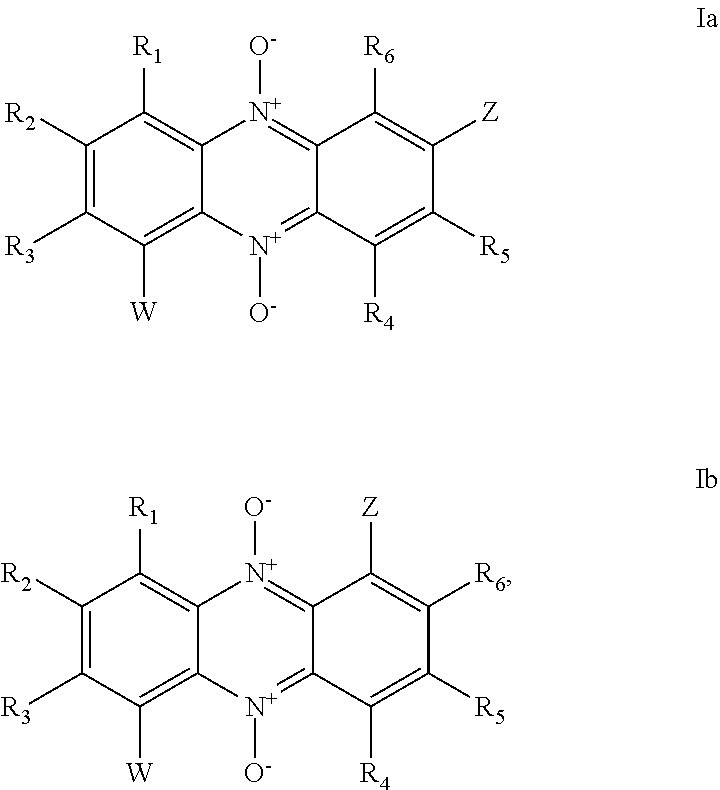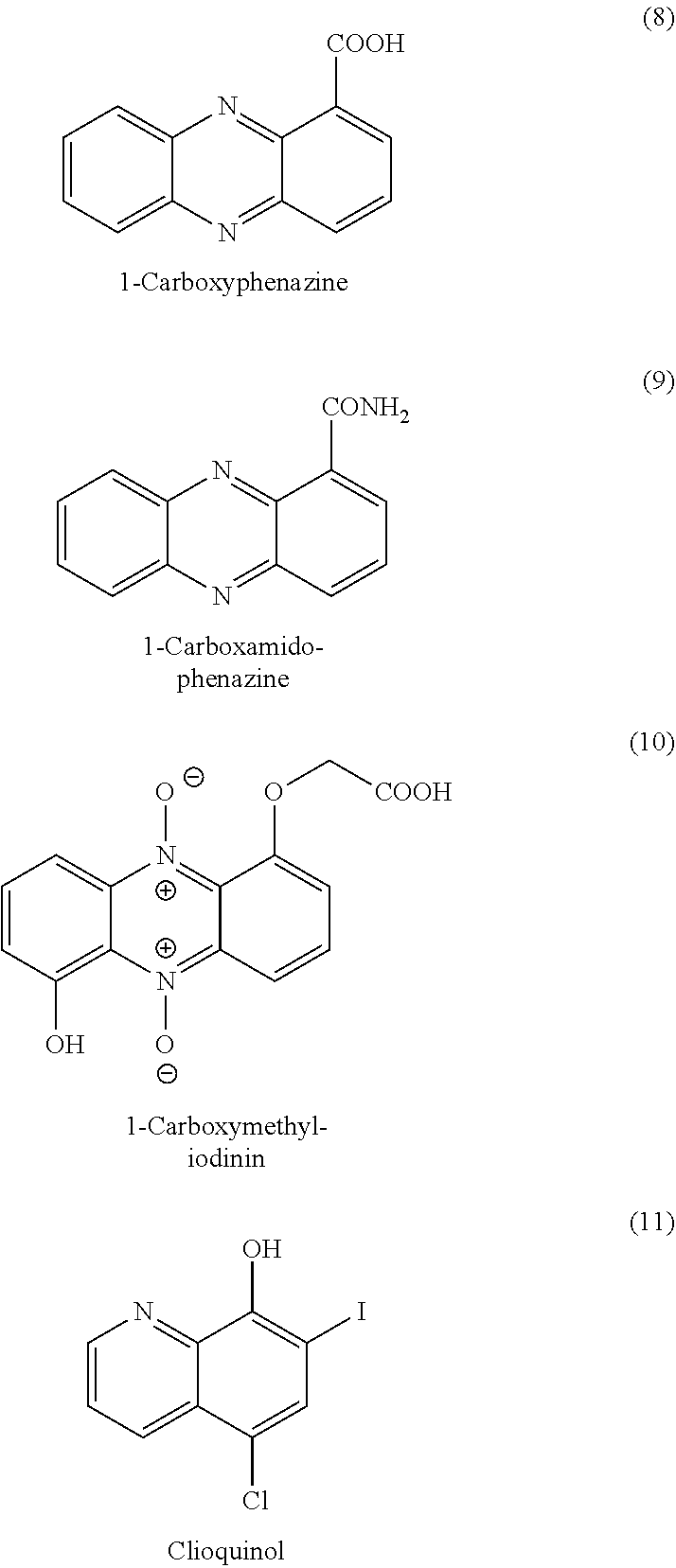Substituted phenazines and methods of treating cancer and bacterial diseases
a technology of substituted phenazines and cancer, applied in the field of substituted phenazines and methods of treating cancer and bacterial diseases, antineoplastic and antiinfective agents, to achieve the effect of improving physico-chemical properties and pharmacokinetics
- Summary
- Abstract
- Description
- Claims
- Application Information
AI Technical Summary
Benefits of technology
Problems solved by technology
Method used
Image
Examples
specific embodiments
i. A compound of general formula (I′), or a pharmaceutically acceptable salt thereof:
[0117]
wherein:
X is an N-oxide functionality (N+—O−), or CH;
Z is a group susceptible to hydrolytic and / or enzymatic cleavage in vivo to form a group selected from —OH, —COOH, —CONH2, —O-Q-COOH and —O-Q-CONH2 (where Q is a straight chained or branched alkylene group, preferably C1-3 alkylene, e.g. methylene), and
Z is optionally linked to one or more targeting groups;
R1 and R2 are independently selected from hydrogen, lower alkyl (e.g. C1-6 alkyl), halogen (e.g. F, Cl, Br, I), an acidic group which is —COOH, —SO3H, —PO3H2 or —B(OH)2; and an aryl group (e.g. phenyl); or
R1 and R2, together with the intervening carbon atoms, form an optionally substituted aromatic group;
each W is independently selected from lower alkyl (e.g. C1-6 alkyl), halogen (e.g. F, Cl, Br, I), OH, and an acidic group which is —COOH, —SO3H, —PO3H2 or —B(OH)2; and
p is an integer from 0 to 3.
ii. A compound as defined in embodiment i, o...
example 1
Route to Iodinin
[0148]
a) Synthesis of 1,6-dimethoxyphenazine (1a)
[0149]
[0150]A dry round-bottom flask with a reflux condenser was charged with 2-bromo-3-methoxyanilin (1.00 g, 4.95 mmol), KHMDS (32 mg, 0.16 mmol, 0.03 eq), BrettPhos Pd G1 Methyl-t-Butyl Ether adduct (118 mg, 0.15 mmol, 0.03 eq) and Cs2CO3 (3.22 g, 9.88 mmol, 2.0 eq). The system was sealed by a rubber septum before air was removed under reduced pressure and replaced by argon (repeated 3 times). Anhydrous toluene (20 mL) was transferred to the flask and the resulting orange coloured suspension gradually warmed up to reflux and left stirring for 24 h. The heating was removed and the crude mixture was cooled to reach rt. The reaction mixture was filtered through a funnel of Celite and undissolved material washed with DCM until no yellow solution came through the funnel. The resulting crude mixture was dry-loaded on silica and purified by flash column chromatography on silica gel (1:7 EtOAc / DCM as eluent) affording 468 m...
example 2
rocedure for the Synthesis of 1-Methoxyphenazines
[0156]7,8-substituted phenazines were synthesized according to procedures published in the prior art by Cushman et al in J. Med. Chem. 2010, 53, 8688-8699 and Huigens III in Angew. Chem. Int. Ed. 2015, 54, 14819-14823.
[0157]A dry round bottomed flask was charged with 3-methoxychatechol (10-20 mmol, under argon atm. Anhydrous Et2O was added (30-60 mL) at room temp and stirred until a clear solution was obtained. This solution was cooled down to −78° C. before O-chloranil (12.5-25 mmol) was added. The temperature (−78° C.) was maintained for 4 h. The resulting crude mixture was filtered twice using a filter paper on a Buchner funnel. The dark crude material obtained was washed with cold ether (−78° C.) and left to dry for 10 min. The solid crude was then transferred to 250 mL round bottom flask containing a solution of the corresponding orthodiphenylamine (2a-e) in 1:1 PhMe / AcOH. The afforded mixture was stirred for 20-24 h at room temp...
PUM
| Property | Measurement | Unit |
|---|---|---|
| reaction time | aaaaa | aaaaa |
| time | aaaaa | aaaaa |
| temperature | aaaaa | aaaaa |
Abstract
Description
Claims
Application Information
 Login to View More
Login to View More - R&D
- Intellectual Property
- Life Sciences
- Materials
- Tech Scout
- Unparalleled Data Quality
- Higher Quality Content
- 60% Fewer Hallucinations
Browse by: Latest US Patents, China's latest patents, Technical Efficacy Thesaurus, Application Domain, Technology Topic, Popular Technical Reports.
© 2025 PatSnap. All rights reserved.Legal|Privacy policy|Modern Slavery Act Transparency Statement|Sitemap|About US| Contact US: help@patsnap.com



